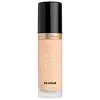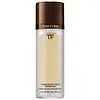Too Faced Born This Way Matte Longwear Liquid Foundation Versus Tom Ford Traceless Soft Matte Foundation
What's inside
What's inside
 Key Ingredients
Key Ingredients

 Benefits
Benefits

 Concerns
Concerns

 Ingredients Side-by-side
Ingredients Side-by-side

Water
Skin ConditioningCyclopentasiloxane
EmollientTrimethylsiloxysilicate
EmollientMethyl Trimethicone
Skin ConditioningButylene Glycol
HumectantPEG/PPG-18/18 Dimethicone
EmulsifyingMagnesium Sulfate
Polyglyceryl-3 Diisostearate
EmulsifyingTribehenin
EmollientPhenyl Trimethicone
Skin ConditioningSilica
AbrasiveSodium Hyaluronate
HumectantTocopheryl Acetate
AntioxidantCocos Nucifera Fruit Juice
EmollientCocos Nucifera Oil
MaskingRhododendron Ferrugineum Extract
MaskingGlycerin
HumectantLecithin
EmollientDimethicone
EmollientMethicone
EmollientDisodium Phosphate
BufferingXanthan Gum
EmulsifyingPropylene Carbonate
SolventDisteardimonium Hectorite
StabilisingCellulose Gum
Emulsion StabilisingLaureth-7
EmulsifyingPolymethylsilsesquioxane
Pentaerythrityl Tetra-Di-T-Butyl Hydroxyhydrocinnamate
AntioxidantSodium Dehydroacetate
PreservativePhenoxyethanol
PreservativeMica
Cosmetic ColorantCI 77891
Cosmetic ColorantCI 77491
Cosmetic ColorantCI 77492
Cosmetic ColorantCI 77499
Cosmetic ColorantWater, Cyclopentasiloxane, Trimethylsiloxysilicate, Methyl Trimethicone, Butylene Glycol, PEG/PPG-18/18 Dimethicone, Magnesium Sulfate, Polyglyceryl-3 Diisostearate, Tribehenin, Phenyl Trimethicone, Silica, Sodium Hyaluronate, Tocopheryl Acetate, Cocos Nucifera Fruit Juice, Cocos Nucifera Oil, Rhododendron Ferrugineum Extract, Glycerin, Lecithin, Dimethicone, Methicone, Disodium Phosphate, Xanthan Gum, Propylene Carbonate, Disteardimonium Hectorite, Cellulose Gum, Laureth-7, Polymethylsilsesquioxane, Pentaerythrityl Tetra-Di-T-Butyl Hydroxyhydrocinnamate, Sodium Dehydroacetate, Phenoxyethanol, Mica, CI 77891, CI 77491, CI 77492, CI 77499
Methyl Trimethicone
Skin ConditioningWater
Skin ConditioningDimethicone
EmollientCaprylic/Capric Triglyceride
MaskingIsocetyl Alcohol
EmollientButylene Glycol
HumectantLauryl PEG-9 Polydimethylsiloxyethyl Dimethicone
Skin ConditioningPEG/PPG-18/18 Dimethicone
EmulsifyingPolymethyl Methacrylate
Trimethylsiloxysilicate
EmollientDimethicone/Vinyl Dimethicone Crosspolymer
Skin ConditioningPhenyl Trimethicone
Skin ConditioningHdi/PPG/Polycaprolactone Crosspolymer
Sodium Hyaluronate
HumectantSilybum Marianum Extract
Skin ConditioningLaminaria Saccharina Extract
Skin ProtectingCorallina Officinalis Extract
Skin ConditioningSigesbeckia Orientalis Extract
Skin ConditioningCucumis Sativus Fruit Extract
EmollientTetrahexyldecyl Ascorbate
AntioxidantAcetyl Hexapeptide-8
HumectantCaffeine
Skin ConditioningLactis Proteinum
Skin ConditioningYeast Extract
Skin ConditioningTocopheryl Linoleate/Oleate
AntioxidantGlycerin
HumectantTrehalose
HumectantMethicone
EmollientCaprylyl Glycol
EmollientSaccharomyces Lysate Extract
HumectantPropylene Glycol Dicaprate
EmollientHelianthus Annuus Seed Extract
Skin ConditioningLavandula Angustifolia Oil
MaskingAcetyl Glucosamine
Skin ConditioningCholesterol
EmollientHordeum Vulgare Extract
EmollientGlycine Soja Protein
EmulsifyingSilica
AbrasiveLecithin
EmollientSodium Chloride
MaskingMagnesium Aluminum Silicate
AbsorbentDisteardimonium Hectorite
StabilisingLauryl Methyl Gluceth-10 Hydroxypropyldimonium Chloride
Dimethicone Silylate
Xanthan Gum
EmulsifyingPEG-4 Dilaurate
EmulsifyingCalcium Chloride
AstringentLinalool
PerfumingBHT
AntioxidantDisodium EDTA
Potassium Sorbate
PreservativePhenoxyethanol
PreservativeCI 77891
Cosmetic ColorantCI 77492
Cosmetic ColorantCI 77491
Cosmetic ColorantCI 77499
Cosmetic ColorantMethyl Trimethicone, Water, Dimethicone, Caprylic/Capric Triglyceride, Isocetyl Alcohol, Butylene Glycol, Lauryl PEG-9 Polydimethylsiloxyethyl Dimethicone, PEG/PPG-18/18 Dimethicone, Polymethyl Methacrylate, Trimethylsiloxysilicate, Dimethicone/Vinyl Dimethicone Crosspolymer, Phenyl Trimethicone, Hdi/PPG/Polycaprolactone Crosspolymer, Sodium Hyaluronate, Silybum Marianum Extract, Laminaria Saccharina Extract, Corallina Officinalis Extract, Sigesbeckia Orientalis Extract, Cucumis Sativus Fruit Extract, Tetrahexyldecyl Ascorbate, Acetyl Hexapeptide-8, Caffeine, Lactis Proteinum, Yeast Extract, Tocopheryl Linoleate/Oleate, Glycerin, Trehalose, Methicone, Caprylyl Glycol, Saccharomyces Lysate Extract, Propylene Glycol Dicaprate, Helianthus Annuus Seed Extract, Lavandula Angustifolia Oil, Acetyl Glucosamine, Cholesterol, Hordeum Vulgare Extract, Glycine Soja Protein, Silica, Lecithin, Sodium Chloride, Magnesium Aluminum Silicate, Disteardimonium Hectorite, Lauryl Methyl Gluceth-10 Hydroxypropyldimonium Chloride, Dimethicone Silylate, Xanthan Gum, PEG-4 Dilaurate, Calcium Chloride, Linalool, BHT, Disodium EDTA, Potassium Sorbate, Phenoxyethanol, CI 77891, CI 77492, CI 77491, CI 77499
Ingredients Explained
These ingredients are found in both products.
Ingredients higher up in an ingredient list are typically present in a larger amount.
Butylene Glycol (or BG) is used within cosmetic products for a few different reasons:
Overall, Butylene Glycol is a safe and well-rounded ingredient that works well with other ingredients.
Though this ingredient works well with most skin types, some people with sensitive skin may experience a reaction such as allergic rashes, closed comedones, or itchiness.
Learn more about Butylene GlycolCi 77491 is also hydrated iron III oxide. It's sole purpose is to give a red/pink hue to products.
Iron III oxides are classified as inorganic chemicals for coloring.
Synthetically created Ci 77491 is considered safer than those naturally found. This is because the synthetically created version may contain less impurities. Iron oxides are generally non-toxic and non-allergenic.
Learn more about CI 77491Ci 77492 is also hydrated iron III oxide. It's sole purpose is to give a yellow hue to products.
Iron III oxides are classified as inorganic chemicals for coloring.
Synthetically created Ci 77492 is considered safer than those naturally found. This is because the synthetically created version may contain less impurities. Iron oxides are generally non-toxic and non-allergenic.
Learn more about CI 77492Ci 77499 is also hydrated iron III oxide. It is created from mixing red and black iron oxides. This helps give shades of darkness to a product.
Iron III oxides are classified as inorganic chemicals for coloring.
Ci 77891 is a white pigment from Titanium dioxide. It is naturally found in minerals such as rutile and ilmenite.
It's main function is to add a white color to cosmetics. It can also be mixed with other colors to create different shades.
Ci 77891 is commonly found in sunscreens due to its ability to block UV rays.
Learn more about CI 77891Dimethicone is a type of synthetic silicone created from natural materials such as quartz.
What it does:
Dimethicone comes in different viscosities:
Depending on the viscosity, dimethicone has different properties.
Ingredients lists don't always show which type is used, so we recommend reaching out to the brand if you have questions about the viscosity.
This ingredient is unlikely to cause irritation because it does not get absorbed into skin. However, people with silicone allergies should be careful about using this ingredient.
Note: Dimethicone may contribute to pilling. This is because it is not oil or water soluble, so pilling may occur when layered with products. When mixed with heavy oils in a formula, the outcome is also quite greasy.
Learn more about DimethiconeDisteardimonium Hectorite comes from the clay mineral named hectorite. It is used to add thickness to a product.
It can also help stabilize a product by helping to disperse other ingredients.
Hectorite is a rare, white clay mineral.
Learn more about Disteardimonium HectoriteGlycerin is already naturally found in your skin. It helps moisturize and protect your skin.
A study from 2016 found glycerin to be more effective as a humectant than AHAs and hyaluronic acid.
As a humectant, it helps the skin stay hydrated by pulling moisture to your skin. The low molecular weight of glycerin allows it to pull moisture into the deeper layers of your skin.
Hydrated skin improves your skin barrier; Your skin barrier helps protect against irritants and bacteria.
Glycerin has also been found to have antimicrobial and antiviral properties. Due to these properties, glycerin is often used in wound and burn treatments.
In cosmetics, glycerin is usually derived from plants such as soybean or palm. However, it can also be sourced from animals, such as tallow or animal fat.
This ingredient is organic, colorless, odorless, and non-toxic.
Glycerin is the name for this ingredient in American English. British English uses Glycerol/Glycerine.
Learn more about GlycerinLecithin is a term for a group of substances found in the cell membranes of plants, animals, and humans. They are made up of mixture of phospholipids.
This ingredient has emollient and emulsifying properties.
As an emollient, lecithen helps soften the skin and creates a barrier to keep moisture in.
As an emulsifier, it also helps prevent water and oil ingredients from separating. Lecithin can also help ingredients be better absorbed by the skin.
This is because the phospholipids in lecithin produce liposomes. Liposomes help other ingredients get through the skin barrier.
Depending on the source of this ingredient, lecithin may not be fungal acne safe. This is because some sources of lecithin come from soybean oil, which may feed the malassezia yeast that feeds fungal acne.
We recommend reaching out to the brand you are purchasing from to inquire about the source of their lecithin.
Some other names for this ingredient include soy lecithin and deoiled soy lecithin.
Learn more about LecithinMethicone is a type of silicone and is a simpler form of dimethicone.
Silicones are used to enhance the texture of products and have emollient properties. Methicone is used to give products a silky texture and improves spreadability.
Methyl Trimethicone is a type of silicone. It is a solvent and emulsifier.
Solvents are used to keep ingredients together in a product. They can help dissolve ingredients to stable bases or help evenly distribute ingredients throughout the product.
Emulsifiers help stabilize a product. It does this by preventing certain ingredients from separating.
Methyl Trimethicone does not get absorbed into the skin.
Learn more about Methyl TrimethiconePEG/PPG-18/18 Dimethicone is a type of silicone.
Phenoxyethanol is a preservative that has germicide, antimicrobial, and aromatic properties. Studies show that phenoxyethanol can prevent microbial growth. By itself, it has a scent that is similar to that of a rose.
It's often used in formulations along with Caprylyl Glycol to preserve the shelf life of products.
Phenyl Trimethicone is a silicon-based polymer. It is derived from silica.
Phenyl Trimethicone is used as an emollient and prevents products from foaming.
As an emollient, it helps trap moisture in the skin. It is considered an occlusive.
Learn more about Phenyl TrimethiconeSilica, also known as silicon dioxide, is a naturally occurring mineral. It is used as a fine, spherical, and porous powder in cosmetics.
Though it has exfoliant properties, the function of silica varies depending on the product.
The unique structure of silica enhances the spreadability and adds smoothness, making it a great texture enhancer.
It is also used as an active carrier, emulsifier, and mattifier due to its ability to absorb excess oil.
In some products, tiny microneedles called spicules are made from silica or hydrolyzed sponge. When you rub them in, they lightly polish away dead skin layers and enhance the penetration of active ingredients.
Learn more about SilicaSodium Hyaluronate is hyaluronic acid's salt form. It is commonly derived from the sodium salt of hyaluronic acid.
Like hyaluronic acid, it is great at holding water and acts as a humectant. This makes it a great skin hydrating ingredient.
Sodium Hyaluronate is naturally occurring in our bodies and is mostly found in eye fluid and joints.
These are some other common types of Hyaluronic Acid:
Learn more about Sodium HyaluronateThis silicone is an emollient. Emollients create a thin film on the skin to prevent moisture from escaping.
It is not soluble in water and helps increase water-resistance in products.
According to a manufacturer, it can blend seamlessly with silicone oils, such as Cyclopentasiloxane.
Learn more about TrimethylsiloxysilicateWater. It's the most common cosmetic ingredient of all. You'll usually see it at the top of ingredient lists, meaning that it makes up the largest part of the product.
So why is it so popular? Water most often acts as a solvent - this means that it helps dissolve other ingredients into the formulation.
You'll also recognize water as that liquid we all need to stay alive. If you see this, drink a glass of water. Stay hydrated!
Learn more about WaterXanthan gum is used as a stabilizer and thickener within cosmetic products. It helps give products a sticky, thick feeling - preventing them from being too runny.
On the technical side of things, xanthan gum is a polysaccharide - a combination consisting of multiple sugar molecules bonded together.
Xanthan gum is a pretty common and great ingredient. It is a natural, non-toxic, non-irritating ingredient that is also commonly used in food products.
Learn more about Xanthan Gum